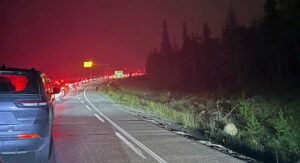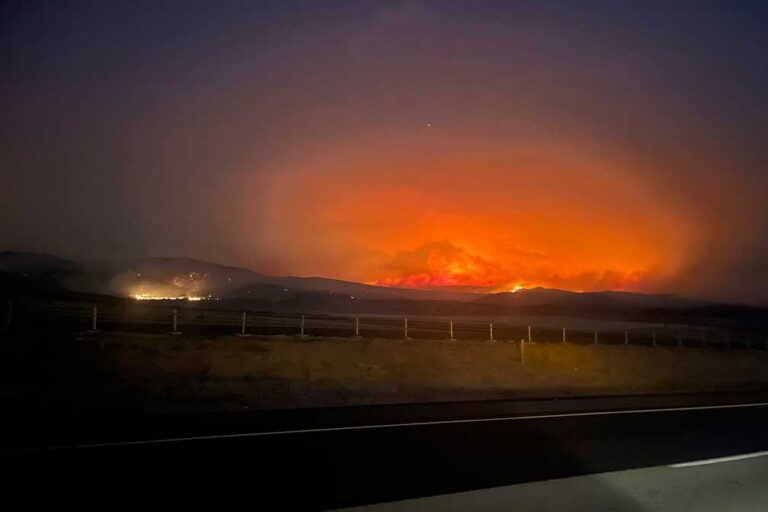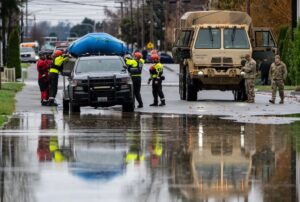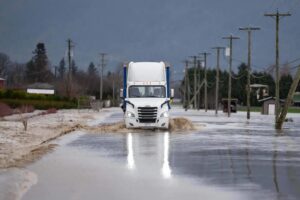BOISE, Idaho — A wildfire burning in Oregon that’s kicking smoke into neighboring states is now the largest active blaze in the U.S., authorities said, and fire crews are bracing for a storm late Wednesday, July 24, that’s expected to bring lightning, strong winds and the risk of flash floods.
The Durkee Fire, burning near the Oregon-Idaho border about 130 miles west of Boise, Idaho, shut down Interstate 84 for hours on Tuesday as the flames approached the vital link between the states. The freeway briefly reopened Wednesday, but then closed again as officials warned of frequent disruptions because of the nearly 400-square-mile blaze.
The town of Huntington, Oregon, home to about 500 people, remained evacuated for a third full day, and authorities issued warnings about the coming storm to those who have remained behind. The storm could bring wind gusts of up to 75 mph, lightning and heavy rain that could cause flash flooding and debris flows in recently burned areas, the Baker County Sheriff’s Office said in a Facebook post.
The Oregon State Fire Marshal’s office also cautioned residents about the risk posed by the storm and the expected “abundant” lightning. The agency has mobilized nearly 500 firefighters to help protect communities that could be threatened by wildfires nearby.
The major electricity utility in the region, Idaho Power, warned customers to prepare for possible outages.
“Power outages and freeway closures are expected. In the event that the fire reaches the City of Huntington, there may be delays in assisting residents that have not previously evacuated,” the sheriff’s office said.
More than 60 significant fires are burning in Oregon and Washington alone, and Oregon has been plagued with hundreds of lightning strikes from thunderstorms that have started new blazes in bone-dry vegetation.
Already, the smoke from the Durkee Fire in Oregon was choking the air in Boise and beyond. An air quality warning was in effect for the entire region on Wednesday.
Patrick Nauman, the owner of Weiser Classic Candy in the small town of Weiser, Idaho, near the Oregon border, said driving into town Wednesday morning was “like driving into a fog bank, because it’s so thick and low to the road.”
Nauman’s shop is on the main intersection in town and is typically a popular spot to stop for lunch or a sugar fix, but customer traffic has dropped by half in the past few days as thick smoke and triple-digit temperatures dogged the region.
“Yesterday you could smell it, taste it, it just kind of hung in the back of your throat,” Nauman said of the smoke.
Mike Cantin, a meteorologist with the National Weather Service in Boise, said cooler air moving into the region Wednesday evening could stoke the Oregon fire. A red flag warning was in effect and the area has been suffering through a heat wave, including many days over 100 degrees Fahrenheit.
“With these winds showing up today, every little spark could get out of hand very easily. It could be a really hazardous situation very fast,” Cantin said. “Don’t light anything on fire and be very careful around grass.”
Wildfires also raging in the Canadian Rockies
Multiple wildfires in the Canadian Rockies’ largest national park sent as many as 25,000 visitors and residents fleeing west over the last open mountain road Tuesday, navigating through darkness and soot following a government alert during the area’s busiest tourist time of the year.

“It’s wall-to-wall traffic,” Carolyn Campbell, a resident of Edmonton, Alberta, Canada, said by phone from her vehicle. “(The smoke) is pretty thick. We’ve got masks in the car.” She said it took hours to move just seven kilometers (about 4 miles), and she worried about others who fled with little gas in their tanks.
Hundreds of wildfires are burning in western Canada, and those fleeing Jasper National Park and Jasper town — home to 4,700 full-time residents — in Alberta province were given the unusual order later Tuesday to make a vast U-turn east if they needed a place to stay. To the west, British Columbia province already had more than 300 wildfires of its own.
Stephen Lacroix with the Alberta Emergency Management Agency said Jasper town estimated about 10,000 people, including seasonal workers, were there when the evacuation call went out. Lacroix said police were going door to door to make sure everyone has left. He also said Parks Canada estimated about 15,000 people had been in the park.
Photos and videos shared on social media Monday night and into Tuesday showed long lines of vehicles, their headlights glowing, inching through swirling tendrils of smoke.
Fires threatening from the northeast cut off highway access east to Alberta’s capital, Edmonton. Another fire roaring up from the south forced the closure of the north-south Icefields Parkway. That left one route open west to British Columbia.
But Alberta fire officials said British Columbia had its hands full with its own evacuations. Alberta Public Safety Minister Mike Ellis said reception centers were instead being set up in Grande Prairie and Calgary in Alberta, requiring long detours through parts of British Columbia by the drivers fleeing the Jasper area.
Alberta has been baking under scorching temperatures that have forced another 7,500 people out of a string of remote communities. About 170 wildfires were burning across the province.
The Municipality of Jasper and Jasper National Park said the evacuation was “progressing well,” and park and town officials scrambled to clear traffic gridlock, find fuel for vehicles and help vulnerable people to safety while marshaling resources to battle the fires.
“Everyone in Jasper must evacuate now,” the Alberta government said in an emergency alert late Monday. Parks Canada noted “an evolving and dynamic situation.”
Evacuees were told they had five hours to clear out — by 3 a.m. Tuesday — and carry with them key documents, pets, medication and any other emergency supplies.
Parks Canada said evacuations had been carried out at numerous campgrounds as well as the Athabasca Hostel and the Palisades Stewardship and Education Centre.
Katie Ellsworth, fire management officer with Parks Canada, said helicopters were dousing targets with water and looking to evacuate hikers who might be trapped in the backcountry.
Jasper National Park said reservations from July 23 to Aug. 6 were being cancelled and would be fully refunded.
Many evacuees at first sought refuge in Valemount, British Columbia, a town of 1,000 people about 120 kilometers (75 miles) west of Jasper.
“The community’s pretty full,” town administrator Anne Yanciw said. “Every parking lot, boulevard, side of the road, field … anything that looks like it could fit a vehicle is full.”
Some evacuees spent the night on the floor of the local arena. A church served a pancake breakfast while drinks, snacks and information were on offer at Valemount’s community hall and visitor center.
“A lot of the fires that we’re fighting right now were (caused by) lightning, and there’s expected to be more coming in the near future,” Alberta Forestry Minister Todd Loewen said.
A record number of wildfires in 2023 forced more than 235,000 people across Canada to evacuate and sent thick smoke into parts of the U.S., leading to hazy skies and health advisories in multiple U.S. cities.
The Associated Press is an independent global news organization dedicated to factual reporting. Founded in 1846, AP today remains the most trusted source of fast, accurate, unbiased news in all formats and the essential provider of the technology and services vital to the news business. The Trucker Media Group is subscriber of The Associated Press has been granted the license to use this content on TheTrucker.com and The Trucker newspaper in accordance with its Content License Agreement with The Associated Press.













